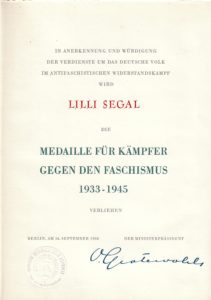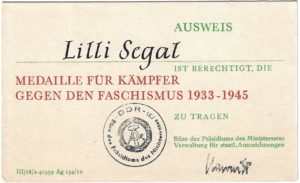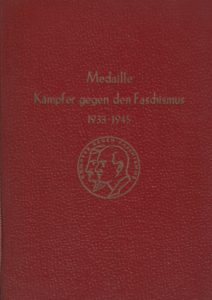Dr. Lilli SEGAL
Lilli Segal was born on June 7, 1913 in Berlin as Lilli Schlesinger and she died in 1999 in Berlin. She was an agronomist and biologist, a political activist and a member of the Résistance.
On the picture shown, taken as she was in custody, at the Prefecture de Police de Paris in November 1943, she smiles, challenging the keeper.
——————————————————————————————————————————————————————————
——————————————————————————————————————————————————————————
For her political commitment she was awarded the Klara Zetkin medal and the “fighter against fascism” medal by the government of the GDR (German Democratic Republic). She was also an honorary member of the district board of the DFB (German Women’s Association of the German Democratic Republic).



Certificates for the „fighter against fascism“ medal (Archiv Michael Peukert/die-dagegen-waren)
Early years
Lilli Segal was the third child of Dr. Arthur Schlesinger, a medical doctor, and his first wife Fanja Zoller, a dentist and nurse from Romania. She was born in Berlin on June 7, 1913. Lilli went to school in Berlin and at Lake Constance and studied law from 1931, but switched to agriculture in 1932.
When Lilli was 9, her mother died of pneumonia as a result of severe diabetes. On April 1, 1933, the day of the boycott of Jewish shops and enterprises in Germany, her father committed suicide.
His second wife, Edith Albrecht, threatened to denounce Lilli to the police as a communist, to make her leave the shared residence. Because of the tightening restrictions for Jews in Germany, Lilli moved to France in 1933 and studied at the Toulouse University of Agriculture.
During her stay in Toulouse she met the student Jakob Segal, a Lithuanian national, who was a member of the German Communist Party (KPD). He had immigrated to France because of his involvement in the communist ‘Red Student Union’. They married on May 25, 1935 and Lilli was given Lithuanian citizenship by virtue of the marriage, which made her a citizen of the Soviet Union from 1940.
Due to her non-German nationality, Lilli Segal was able to travel to Germany without any difficulties after 1935. During these trips she took on several missions for the KPD without being a member of the party. These were among other things the housing of endangered comrades, the production and distribution of leaflets, and courier activities. In addition, she remained in contact with a group of Bavarian Catholic officers who were opponents of the Hitler regime. They provided her with money for political work.
Until the outbreak of war, Lilli Segal worked in a laboratory in Paris from 1937. She joined the French Communist Party, with which she was regularly involved until the beginning of the war. Because they feared that she was under surveillance by the Gestapo, the French comrades broke off the connection with her.
When Germany occupied France, she left Paris and lived in Mende. In the summer of 1943 party leaders decided to transfer Lilli Segal to the same working group as her husband, because both had lived together for a long time and worked in the same office.
From 1943 until her arrest she worked as a so-called liaison agent for her husband, who worked at the technical headquarters of a party section which dealt with transporting materials, as well as the contact management of liaisons with the headquarters.
The persecution of party official Paul Grasse led the police to their office in the summer of 1943. With the arrest of a number of German and Austrian party comrades on November 23rd Paul Grasse also disappeared.
Lilli Segal was also questioned by the French police (see picture above) at the Prefecture de Police. She was not cooperative and was arrested as a result. After a month, she was handed over by the French police to the German run jail of Fresnes., where she remained until the end of June 1944.
At the end of June, she was taken t Drancy, and after a month, on 31 July 1944, Lilli Segal was deported to Auschwitz in Convoi 77. In the train, she made contact with two Austrian comrades; one of them was Anni Sussmann, with whom she was transferred in November 1944 to a Labour unit at Kratzau in the Sudetenland. (1)
Escape
On November 21, 1944 Lilli Segal fled their unit together with Anni Sussmann. They hid in a forest and moved on after nightfall. They met French prisoners of war near the town of Zittau, who hid them on a farm. With the help of these prisoners they reached Dresden. There the employees of her grandmother and some Protestant friends helped them further. They were given clothes and money and made their way through all of southern Germany to Radolfzell on Lake Constance, where they crossed the Swiss border on foot on December 3, 1944. Lilli Segal sent a message from there to her husband, Jakob Segal. She was repatriated to France in March 1945 together with Anni Sussmann. (1)
Post-war years
After returning to France, Lilli Segal continued working for the French Communist Party until 1947. (5) Since it became prohibited for Soviet citizens to work for a political party abroad, she left France together with her husband, Jakob Segal, and they emigrated to the German Democratic Republic. From 1948 she worked in the GDR in various official political organizations, e.g. as an interpreter. (1)
The heritage of her father had been seized by the Nazis upon his death, and Lilli Segal tried to get it back from the reparations offices that had been created in the GDR. The heritage consisted of several plots of land as well as shares and securities.
However, her father’s second wife, Edith Albrecht, had been declared sole heiress, since Lilli and two other siblings had been living abroad at the time of her father’s death. When Edith Albrecht tried to sell a plot of land after Lilli Segal had moved to the GDR, a lawsuit over the heritage of Dr. Arthur Schlesinger ensued.
It turned out that Mrs Albrecht was not allowed to sell the property because she did not meet the requirements of the refund committee orequirements. She did not belong to the category of racially persecuted persons, and since political persecution was not proven either, she could not sell the plot. (5, 10, 11)
This was followed by a restitution conflict on the part of Lilli Segal regarding her father’s heritage. The negotiations concerned the restitution of land, shares and securities. Ultimately, the legacy was split among Dr. Arthur Schlesinger’s children and his wife, Mrs Albrecht. Lilli Segal received the plot at the Berlin address Southwest Rail Road 10 and the assignment of war damages. (5, 10, 11)
From 1956 Lilli Segal worked as a biologist at Humboldt University in Berlin. (1)
From then on the only sources of information are an article in the magazine “Der Spiegel” 1991 (6), reporting on Lilli and Jakob Segals’ lives, and some letters concerning the issuing of a new identity document in the year 1992.(1)
Lilly Segal died in Berlin in 1999.
Editor’s note :
1- Lilli Segal wrote a very instructive book, availabe in English, under the title : From Protest to Resistance.
2- 2- Lilli and Jakob SEGAL were certainly manouvered by the east german and russian secret services to broadcast a fake news about the “creation of AIDS in a US laboratory”. See the excellent report by Anders JEPPSON from the Lund University, Department for Global Health & Social Medicine, Malmo¨, Sweden
https://journals.sagepub.com/doi/pdf/10.1177/2325957417724203

Lilli Segal (geboren als Lilli Schlesinger am 7. Juni 1913 in Berlin, gestorben 1999 in Berlin) war Doktorin der Agrarwissenschaften und Biologie, aber auch politische Aktivistin und Widerstandskämpferin während des Zweiten Weltkriegs.
Auf nebenstehendem Foto, welches während ihrer Festnahme im November 1943 in der Pariser Polizeipräfektur entstand, wirkt es als würde sie den Gefängniswärter verspotten.
Sie erhielt die Clara-Zetkin-Medaille der Deutschen Demokratischen Republik für ihr politisches Engagement und ihren Kampf gegen den Faschismus. Außerdem war sie Ehrenmitglied des Bezirksvorstands des DFD (Demokratischer Frauenbund Deutschland, Frauenorganisation der DDR).
Frühe Jahre
Lilli Segal war das dritte Kind des Arztes Dr. Arthur Schlesinger und seiner ersten Frau Fanja Zoller, einer Zahnärztin und Krankenschwester aus Rumänien. Sie wurde am 7. Juni 1913 in Berlin geboren. Lilli ging in Berlin und am Bodensee zur Schule und studierte ab 1931 Jura, wechselte dann aber zu Agrarwissenschaften im Jahr 1932.
Als Lilli 9 Jahre alt war, starb ihre Mutter an einer Lungenentzündung in Folge einer schweren Diabeteserkrankung. Am 1. April 1933, dem Tag des Boykotts jüdischer Geschäfte und Unternehmen in Deutschland, beging ihr Vater Suizid.
Seine zweite Frau, Edith Albrecht, drohte damit, Lilli bei der Polizei als Kommunistin zu denunzieren um sie aus der gemeinsamen Wohnstätte zu vertreiben. Aufgrund der zunehmenden Einschränkungen für Juden in Deutschland, zog Lilli 1933 nach Frankreich und studierte an der agronomischen Universität in Toulouse.
Während ihrer Zeit in Toulouse lernte sie den Studenten Jakob Segal, einen litauischen Staatsangehörigen, kennen, welcher Mitglied der Kommunistischen Partei Deutschlands (KPD) war. Nach Frankreich war er für die kommunistische „Rote Studentenunion“ gekommen. Die beiden heirateten am 25. Mai 1935, wodurch Lilli die litauische Staatsbürgerschaft erhielt. Dadurch war sie ab 1940 auch Staatsbürgerin der Sowjetunion.
Dank dieser nicht-deutschen Staatsbürgerschaft konnte Lilli Segal nach 1935 problemlos nach Deutschland reisen. Während dieser Reisen übernahm sie mehrere Missionen für die KPD ohne Parteimitglied zu sein. Unter Anderem brachte sie sich in Gefahr befindende Genossen unter, organisierte die Produktion und Verteilung von Flyern und übernahm Kuriertätigkeiten. Zudem war sie in Kontakt mit einer Gruppe bayerischer katholischer Offiziere, die Gegner des Hitlerregimes waren und ihr bei der Finanzierung der politischen Arbeit halfen.
Von 1937 bis zum Beginn des Krieges arbeitete Lilli Segal in einem Labor in Paris. Sie wurde Mitglied der Französischen Kommunistischen Partei, in deren Arbeit sie bis zum Kriegsausbruch regelmäßig involviert war. Aus Angst, dass sie von der Gestapo überwacht werden könnte, brachen die französischen Genossen jedoch dann den Kontakt mit ihr ab.
Als die Deutschen Frankreich besetzten, verließ Segal Paris und zog nach Mende. Im Sommer 1943 ordnete die Parteiführung Lilli Segal derselben Arbeitsgruppe zu, der ihr Ehemann angehörte, da beide seit langem zusammen lebten und im selben Büro arbeiteten.
Von 1943 bis zu ihrer Verhaftung arbeitete sie als sogenannte Verbindungsagentin für ihren Mann, welcher in der technischen Zentrale der Partei tätig war, die den Transport von Materialien sowie den Kontakt mit der Parteizentrale organisierte.
Im Sommer 1943 führte die Verfolgung des Parteifunktionärs Paul Grasse die Polizei zu ihrem Büro. Bei der Verhaftung einiger deutscher und österreichischer Parteimitglieder am 23. November verschwand auch Paul Grasse.
Lilli Segal wurde von der französischen Polizei in der Polizeipräfektur vernommen (vgl. obiges Foto). Sie kooperierte nicht und wurde deswegen festgenommen. Nach einem Monat wurde sie von der französischen Polizei an das deutsch-geführte Gefängnis Fresnes übergeben, wo sie bis Ende Juni 1944 verblieb.
Ende Juni wurde sie nach Drancy gebracht, von wo aus sie nach einem Monat, am 31. Juli 1944, im Konvoi 77 nach Auschwitz deportiert wurde. Im Zug knüpfte sie Kontakt mit zwei österreichischen Genossen; eine der beiden war Anni Sussmann, mit der Lilli im November 1944 zur Arbeitseinheit in Kratzau im Sudetenland transferiert wurde. [1]
Flucht
Am 21. November 1944 floh Lilli Segal zusammen mit Anni Sussmann. Sie versteckten sich in einem Wald und zogen in der Nacht weiter. Nahe der Stadt Zittau trafen sie französische Kriegsgefangene, die sie auf einem Bauernhof versteckten. Dank der Hilfe dieser Kriegsgefangenen erreichten sie Dresden. Dort halfen ihr die Angestellten ihrer Großmutter und einige protestantische Freunde. Sie erhielten Kleidung und Geld und schafften es durch ganz Süddeutschland nach Radolfzell am Bodensee zu reisen, von wo aus sie am 3. Dezember 1944 zu Fuß die schweizerische Grenze überquerten. Lilli Segal sendete dann von dort aus eine Nachricht an ihren Mann, Jakob Segal. Am März 1945 kehrte sie mit Anni Sussmann nach Frankreich zurück. [1]
Nachkriegsjahre
Nach ihrer Rückkehr nach Frankreich arbeitete Lilli Segal bis 1947 weiter für die Französische Kommunistische Partei. [5] Als es dann sowjetischen Staatsbürgern verboten wurde für politische Parteien im Ausland zu arbeiten, verließ sie Frankreich gemeinsam mit ihrem Mann, Jakob Segal, und emigrierte in die DDR. Ab 1948 arbeitete sie in der DDR für verschiedene offizielle politische Organisationen, unter anderem als Übersetzerin. [1]
Das Erbe ihres Vaters war von den Nazis nach seinem Tod konfisziert worden und Lilli Segal versuchte es mithilfe der Behörden, die in der DDR für Entschädigungszahlungen kreiert worden waren, zurück zu erlangen. Das Erbe bestand aus mehreren Grundstücken sowie Anleihen und Wertpapieren.
Allerdings war die zweite Frau ihres Vaters, Edith Albrecht, zur Alleinerbin deklariert worden, da Lilli und zwei andere Geschwister zur Zeit des Todes ihres Vaters im Ausland lebten. Als Edith Albrecht versuchte ein Grundstück zu verkaufen nachdem Lilli Segal in die DDR gezogen war, folgte ein Gerichtsverfahren über das Erbe von Dr. Arthur Schlesinger.
Es stellte sich heraus, dass Frau Albrecht das Grundstück nicht verkaufen durfte, da sie die Voraussetzungen der für die Erstattung zuständigen Behörden nicht erfüllte:sie gehörte weder zur Kategorie rassistisch verfolgter Personen, noch konnte eine politische Verfolgung belegt werden. [5, 10, 11]
Darauf folgte von Seiten Lilli Segals die erneute Forderung nach Rückerstattung bezüglich des Erbes ihres Vaters. In den Verhandlungen ging es um die Rückerstattung von Land, Anleihen und Wertpapieren. Letztendlich wurde das Erbe zwischen Dr. Arthur Schlesingers Kindern und seiner Gattin, Frau Albrecht, aufgeteilt. Lilli Segal erhielt ein Grundstück in Berlin sowie Schadensersatzzahlungen für die im Krieg erlittenen Schäden. [5, 10, 11]
Ab 1956 arbeitete Lilli Segal als Biologin an der Humboldt-Universität in Berlin [1].
Aus späteren Zeiten gibt es nur noch einen Artikel aus dem Spiegel-Magazin von 1991 [6], welcher über Lilli und Jakob Segals Leben berichtet, sowie einige Briefe über die Ausstellung neuer Ausweisdokumente im Jahr 1992. [1]
Lilli Segal starb in Berlin im Jahr 1999.
Anmerkung der Redaktion:
1- Lilli Segal verfasste ein sehr lehrreiches Buch mit dem Titel „Vom Widerspruch zum Widerstand“.
2- Lilli und Jakob SEGAL wurden vermutlich von den ostdeutschen und russischen Geheimdiensten dazu gebracht, eine gefälschte Nachricht über die “Entstehung von AIDS in einem US-Labor” zu verbreiten. S. Bericht von Anders JEPPSON von der Universität Lund, Abteilung für globale Gesundheit und Sozialmedizin, Malmö, Schweden https://journals.sagepub.com/doi/pdf/10.1177/2325957417724203


 Français
Français Polski
Polski











Dear german students and Professor, I would like to thank you for this insightful biography. I was eager to discover the life of this woman, with who my mother, Régine Skorka Skorka Jacubert, was inmate, both in Auschwitz and in Kratzau (Kommando of Gross Rosen, dedicated to ammunition manufacture, in now northern Check republic. The selection for departure to Krazau, among other destinations, took place on 28 October, that day, the Russians had reached Krakow. Serge JACUBERT.
I am the daughter of margo who you contacted.
Loved this thank you.
Leah kaufman
Dear Margo and Leah,
we are grateful for the authorization and the copies of the photos of Lilli and her close relatives. We want to emphasize, once more, the INTEREST we had in reading the insightful book written by Lilli and translated into English, thanks to Margo.
Serge Jacubert and the whole board of the Association, Convoi 77
Au camp de Drancy, Lilli Segal a retrouvé Lilli FISCH, résistante d’origine autrichienne, qu’elle a d’abord croisée dans les locaux de la gestapo rue des Saussaies en juillet 1944. Serait-ce la seconde résistante autrichienne dont parle la bio ci-dessus?
I am the daughter of Herbert, Lilli’s brother. This is a wonderful synopsis of Aunt Lilly’s life that I am excited to share with my own children. Thank you!
Dear Susan,
your aunt was with my mother in both Auschwitz and Kratzau (now known as Chrastava, in the Check republic) from where she flew away. In the name of our Association, thank you for your message.
Hello, my plant physiology mentor was one of the last students of Jascha and Lilli Segal at the Humboldt University.
Could you imagine Students, that will work the whole day in the Institute and in the evening everyone is following to the Segal’s home to discuss a few hours more and come back early the next morning? It was really existing for him. He showed me the dialectic perspective of the Segal’s for natural sciences. And I can understand, why on his writing desk was always a picture of Jascha.
Sadly, he died a few years ago still in Berlin.
The publication “Die Entstehung des Lebens aus Biophysikalischer Sicht” (The origins of life from a biophysical point of view) was and is an eyeopener for me and still the best scientific work in this field.
I have read the German version of “From Protest to Resistance” and it would be a privilege to come in contact with relatives of Lilli and Jascha.
There is a small addition to Anni Sussmann for the Association.
http://www.doew.at/erinnern/biographien/erzaehlte-geschichte/exil/anna-sussmann-ex-autrichienne
Thank you!
Dear Thorsten,
the message was handed over to Margo, and we hope that the contact was made. Thanks a lot for this testimony, the link to Anni Sussmann’s resumé, and best regards from the Association.
I was happy to see this. I interviewed Lilli on video in 1990 in her apartment in Berlin. What an amazing woman.
Dear Jesse,
thanks for your message. If the video of the interview is available, we would be delighted to get a copy. I will send you a private email.
Best regards
Serge Jacubert
Dear Thorsten Perl
Thank you very much for the link to Anna Sussmann bio. It’s precious. Can you tell us more about the origin of these excerpts? A book? Document in an Archive Center?
Best
Ms Laurence KLEJMAN c.77
Lili Segal est arrêtée dans une filature qui concerne Joseph Ullmann et Sally GRYNVOGEL, déporté aussi par le convoi 77, dans une affaire traitée par la BS1 dite “Affaire Pierre Marcel”. Elle est arrêtée sur son lieu de travail ( traductrice au cabinet Coutant 21 rue de la Banque) mais refuse de donner son adresse.